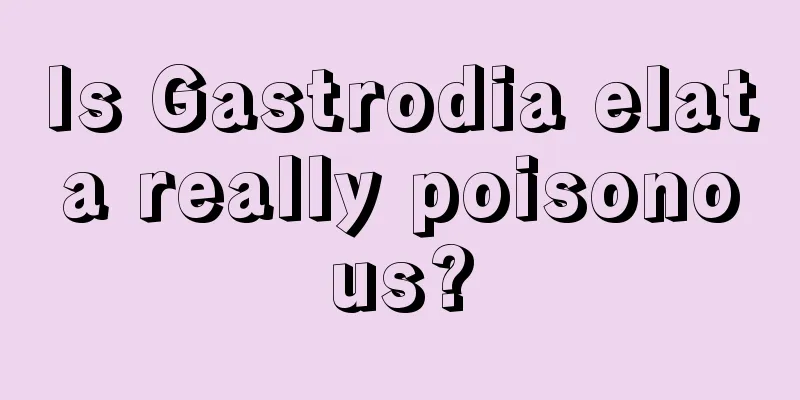Is Gastrodia elata really poisonous?

1. The whole body is full of poisonThe entire body of the herb is poisonous, with the roots and leaves being the most toxic. Its toxicity mainly comes from the gelemine it contains. It is highly toxic to the human nervous system. Once people accidentally eat it, it will suppress the human nervous system and even cause the heart to stop beating. After eating the herb, people will feel a burning sensation in the mouth and throat, vomit, and feel as if their intestines are about to break. These are just manifestations of the suppression of the nervous system. 2. Emergency measures after poisoningAfter eating the herb, people will feel constant abdominal pain, their intestines will turn black and stick together, and they will eventually die from abdominal pain. If poisoning is discovered, seek medical attention immediately. If the hospital is far away and the situation is critical, there are several emergency measures: 1. Use chicken or duck feathers dipped in cooking oil to wipe the patient's throat to induce vomiting, and then feed peanut oil after vomiting; 2. Take fresh duck or goose blood; 3. Mix duck egg white and peanut oil and take orally; 4. Mash the stems and leaves of honeysuckle together and add brown sugar to drink; 5. Take mung bean soup orally. There is currently no good treatment method, and the general methods used are gastric lavage, adsorption of poisons, and vomiting. In addition, some people found that sheep did not die after eating the herb Gnaphalium, and that administering fresh sheep blood also had a good therapeutic effect. 3. Medicinal ValueAlthough the whole body of Gelsemium elegans is poisonous, it is actually a traditional Chinese medicine and its entire body can be used as medicine. Because Gelsemium elegans is highly toxic, it is generally not taken orally and is made into an external medicine. External use has a good effect on skin diseases such as eczema, tinea corporis, tinea pedis, and surgical diseases such as rheumatism, bone pain, and contusions. 4. Ornamental ValueAlthough Gelsemium elegans is a highly poisonous plant, it looks very beautiful. Every spring when all flowers are in full bloom, Gelsemium elegans also blooms beautiful flowers. Its flowers look very similar to honeysuckle, with clusters of small yellow flowers. However, since the whole plant of Gelsemium elegans is poisonous, it is best not to pick it. You can only look at it from a distance and not play with it. |
<<: The flower language and value of lucky grass
>>: Is Dutch chrysanthemum poisonous?
Recommend
Don’t throw away watermelon rinds randomly, they are the best way to cool down in summer, and their effect is better than old ginseng!
Watermelon rind and mung bean soup: clearing away...
Why is autumn the best time to transplant peonies? (What season is suitable for planting peonies?)
Spring is not suitable for planting peonies Peony...
How to propagate Haworthia by cuttings How to propagate Haworthia by cuttings
Haworthia is a succulent plant with many varietie...
Cutting propagation method of Pinnatifida
time Cutting propagation of Phlox featherleaf can...
The efficacy and function of sugarcane juice, how to make sugarcane juice
1. Efficacy and effects 1. It can quench thirst: ...
When and how to plant big leaf spinach
When to plant spinach Large-leaf spinach needs to...
What to do if the leaves of the goldenrod fall off
reason Low temperature Low temperature is one of ...
How to plant honeysuckle, pictures of honeysuckle
1. Timely Valuation The right time should be chos...
How to grow grapes?
Grape varieties can generally be divided into win...
How to propagate the green lily
Mode of reproduction There are three ways of prop...
Learn these 5 bonsai shaping techniques now!
(1) Direct dry type Bonsai trees have only one ma...
Forget-me-not flower language and meaning
1. Flower Language Its flower language is very be...
What to do if the leaves of the green radish tree turn yellow in spring
1. Causes 1. The temperature conditions are not v...
A complete list of common succulent varieties suitable for cultivation in the north!
Qingshengjin Qingsheng Jin can grow normally in a...
Looking back at April, the flowers are blooming on every tree!
The small garden in the dim light of morning is a...









